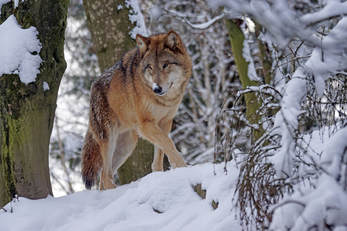
It’s easy to take our canine friends for granted when they’ve been by our side virtually since the dawn of humanity. But have you ever stopped to consider how on earth your hyper, loyal (and maybe not so smart) furry friend was originally descended from the wild, clever, and fearful wolf?
It all started with the gray wolf tens of thousands of years ago. The theory goes that humans began taking in and taming wolf pups that would rummage through human trash, and since wolves are pack animals, it was relatively easy for them to fit in with their new human “packs.” Somewhere down the line, we humans realized that a relationship with these tamer wolves was extremely beneficial for hunting, and the rest is history.
We know that dogs were descended from wolves through DNA evidence, but other than that, the specifics of domestication history is actually not very well understood. For example, where exactly were they first domesticated? Some claim the Middle East, while others say Europe or East Asia, but no one really knows for sure. Greger Larson, an archaeologist and geneticist, says that because dogs were domesticated so long ago and have cross-bred so many times throughout history, that their genes are like “a completely homogeneous bowl of soup.”
And here’s another interesting tidbit: in the 20th century, a Russian geneticist named Dmitri Belyaev attempted to find out why domesticated dogs look and act so much different from their wolf ancestors. To do this, he bred tame foxes for several generations until he noticed that they began to display similar typical features of dogs that are normally absent in wild foxes, including floppy ears, shorter snouts, spotted coats and the tendency to bark.
Based on DNA, we know that dogs were descended from wolves and not foxes, so what the above information tells us is that the these specific dog characteristics cannot be a product of natural selection, but rather that the genes that account for tameness must also carry a code for things like barking or spotted coats.
To complicate matters even more, some researchers, like Larson, believe that dogs may have even been domesticated twice. His theory on this says that humans in western Eurasia domesticated the gray wolf, while at the same time, humans farther east in Asia were also domesticating gray wolves. Around the time of the Bronze Age, humans from the East began migrating, with their canine companions, westward. Upon meeting, the western dogs mated with the eastern dogs, resulting in a new branch in the domestication tree.
Confused yet? Don’t worry, no one really knows all the answers to this mystery, and at this point Larson says that the only way we’ll ever know the full truth about the domestication of dogs is “to go back in time.” Just be happy that your furry companion is (hopefully) much more cuddly and playful than a gray wolf!
It all started with the gray wolf tens of thousands of years ago. The theory goes that humans began taking in and taming wolf pups that would rummage through human trash, and since wolves are pack animals, it was relatively easy for them to fit in with their new human “packs.” Somewhere down the line, we humans realized that a relationship with these tamer wolves was extremely beneficial for hunting, and the rest is history.
We know that dogs were descended from wolves through DNA evidence, but other than that, the specifics of domestication history is actually not very well understood. For example, where exactly were they first domesticated? Some claim the Middle East, while others say Europe or East Asia, but no one really knows for sure. Greger Larson, an archaeologist and geneticist, says that because dogs were domesticated so long ago and have cross-bred so many times throughout history, that their genes are like “a completely homogeneous bowl of soup.”
And here’s another interesting tidbit: in the 20th century, a Russian geneticist named Dmitri Belyaev attempted to find out why domesticated dogs look and act so much different from their wolf ancestors. To do this, he bred tame foxes for several generations until he noticed that they began to display similar typical features of dogs that are normally absent in wild foxes, including floppy ears, shorter snouts, spotted coats and the tendency to bark.
Based on DNA, we know that dogs were descended from wolves and not foxes, so what the above information tells us is that the these specific dog characteristics cannot be a product of natural selection, but rather that the genes that account for tameness must also carry a code for things like barking or spotted coats.
To complicate matters even more, some researchers, like Larson, believe that dogs may have even been domesticated twice. His theory on this says that humans in western Eurasia domesticated the gray wolf, while at the same time, humans farther east in Asia were also domesticating gray wolves. Around the time of the Bronze Age, humans from the East began migrating, with their canine companions, westward. Upon meeting, the western dogs mated with the eastern dogs, resulting in a new branch in the domestication tree.
Confused yet? Don’t worry, no one really knows all the answers to this mystery, and at this point Larson says that the only way we’ll ever know the full truth about the domestication of dogs is “to go back in time.” Just be happy that your furry companion is (hopefully) much more cuddly and playful than a gray wolf!





 RSS Feed
RSS Feed

